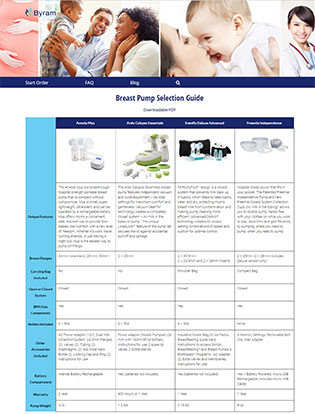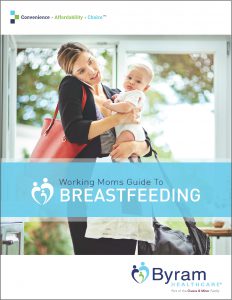Explore Baby-Led Weaning (BLW)
Baby-led weaning is a method of introducing foods that promotes independence and the development of fine motor skills. It allows babies to self-feed solid foods instead of starting with purees and spoon-feeding. With BLW, babies are offered appropriately sized pieces of soft, whole foods that they can pick up and eat independently. Here, we'll review everything you need to know about BLW and how to start.
What Are the Benefits of Baby-Led Weaning?
Choosing to focus on baby-led feeding may have some benefits for your baby. However, more research is needed to understand the full effects of this approach. Still, several experts believe that there are plenty of advantages of BLW, some of which include:
- Baby-led weaning encourages independence and control from an early age, allowing them to eat at their own pace.
- It helps babies practice motor and oral skills.
- It creates a healthy relationship with food, as they learn to stop when they’re full based on instincts and feelings.
- They're introduced to a variety of different textures and flavors, which can help spark an interest in food and decrease picky eating during toddlerhood.
- Real foods are introduced rather than pre-packaged, highly processed alternatives.
- Your baby gets to be integrated into family mealtimes from an early age.
- Baby-led approaches make it easier for children to eat with you in restaurants on a night out.
- This approach can count as sensory play, as infants use several different senses when exploring their meals.
With that being said, baby-led weaning is not for everyone. During the early months when your infant starts solid foods, BLW is a big commitment. You need to give your baby time to explore new foods and not rush them to finish a meal. You'll also need to schedule plenty of time to clean up, as food tends to end up in places you didn't even know existed. Ultimately, the decision is up to you, but if you decide to let your baby take the lead, there are some things to know.
Considerations Before Introducing Solid Foods Using BLW
One thing parents need to keep in mind about BLW is that it poses a risk of choking. Since your baby is taking control of the feeding, finger foods must be cut extremely small and in safe shapes. You can also reduce choking hazards by offering your baby soft foods, although supervision is still essential. Some experts also find that BLW may cause nutritional concerns since the baby may be unable to initially self-feed effectively.
To combat these issues, it's important to ensure you only start weaning your baby when they show signs of readiness. These signs are the same as those for introducing solid foods to your baby in a more traditional approach, i.e., good head control and the ability to sit up on their own. Typically, this is around 6 months, but every child is different. Do not start BLW before your baby is ready, and if you have any questions on this timeline, speak to your pediatrician.
You should also never, under any circumstance, leave your baby unattended during BLW meals. You need to be present for the entire time to ensure that things are going well and your baby doesn't choke. This is non-negotiable.
Best Baby-Led Weaning Foods to Introduce to Your Baby
When starting baby-led weaning, choosing foods that are safe, nutritious, and easy for little hands to grasp is important. Since babies are still learning to chew and swallow, foods should be soft enough to mash between their gums but firm enough to hold without falling apart. Ideal first foods include a variety of textures and flavors to encourage exploration and healthy eating habits. Always ensure pieces are cut into finger-sized portions to reduce the risk of choking. Some of the best foods for baby-led weaning include:
- Soft fruits (i.e., ripe bananas, avocado slices, steamed/cooled apples)
- Steamed vegetables (i.e., carrot sticks, broccoli florets, sweet potato)
- Shredded chicken
- Scrambled eggs
- Pieces of tofu
- Soft beans
- Nut butter (small portions and only when you have time to monitor for allergic reactions)
- Toast trips
- Cooked pasta
- Oatmeal
- Rice cakes
- Soft-cooked rice
- Plain yogurt
- Small pieces of cheese
Just make sure that any steamed foods are, in fact, soft enough to help reduce the risk of choking. There are also a few foods to avoid in order to optimize safety. These include:
- Round foods (i.e., whole grapes)
- Hard or sticky food
- Whole nuts
- Raw carrots
- Honey (honey is not safe for infants)
- High-mercury fish
- Steak
Please ask your pediatrician if you have any questions about which foods may be problematic.
Tips to Help You Start Baby-Led Weaning
If you want to try baby-led weaning, consider some tips to help you get started.
Get Ready for a Mess
Even if you take every precaution possible, BLW can be messy. Embrace it! It's all part of the process. Mentally preparing yourself can help you see the fun side of things rather than getting stressed when some (maybe most) of the food ends up on the floor, walls, and even your face. You can use bibs and splash mats to help try and contain the mess, but babies exploring pieces of food is great for their fine motor skills, so be patient. They will get the hang of it eventually.
Choose Baby-Safe, Soft Foods
Baby-led weaning focuses on introducing a range of foods you'd eat at mealtime rather than packaged baby food. However, you must ensure that everything is cooked and portioned accordingly. After cooking, let the food cool to room temperature to avoid burns. Choose any of the approved, safe foods we mentioned above, and provide the right portion based on age. You may also want to introduce healthy foods slowly, with a new one given every three to four days. This can help you determine whether your child is intolerant or allergic to any given item.
Check for Allergic Reactions
Foods like peanut butter, eggs, and dairy should be introduced with care, as these are common allergens in children. Although you shouldn't avoid giving your children these foods, there are safe ways to do so. Follow the guidelines by your pediatrician and some of our tips on introducing allergens to infants. The key is ensuring you have enough time to closely monitor your baby after eating so you can watch for any signs of allergic reactions and take action accordingly.
Offer a Variety of Foods
Introducing healthy foods early can help reduce pickiness later in life, so don't be afraid to get creative. You can give your baby several vegetables and fruits as long as they've been cooked and chopped. More firm foods can be incorporated into meals as your baby grows, but supervision is still essential.
Focus on Iron Intake
Iron is crucial during baby-led weaning because babies’ natural iron stores start to deplete around 6 months, just as they begin eating solid foods. Iron supports brain development, immune function, and oxygen transport in the blood. Since breast milk and formula alone may not provide enough iron at this stage, offering iron-rich foods helps prevent iron deficiency anemia and supports healthy growth.
Don't Force Them to Overeat
One of the key principles of baby-led weaning is allowing babies to listen to their own hunger and fullness cues rather than being pressured to finish a set amount of food. Forcing a baby to eat beyond their appetite can lead to overeating habits later in life and disrupt their natural ability to regulate food intake. Instead, trust your baby to eat what they need—some days, they may eat more, while others, they may eat less. If you have concerns about their appetite, talk to your pediatrician.
Try a Combination of Both
Baby-led weaning is great, but it's not the only way to introduce your baby to solid foods. You can reap both benefits by incorporating some elements of baby-led and traditional weaning to feed your baby during those first few years. It's really up to you. As long as your infant is getting all the essential nutrients and meeting their developmental milestones with weight gain, the way you get your baby to eat different foods is really up to you. So, have some fun with it, and don't forget to supplement solid food with breast milk or formula during the transition.
To help ensure your baby gets all the nutrients they need during development and the introduction of solid foods, supplement feedings with breast milk. To help you make the most out of your feedings, order an insurance-covered breast pump from Byram Healthcare today.





